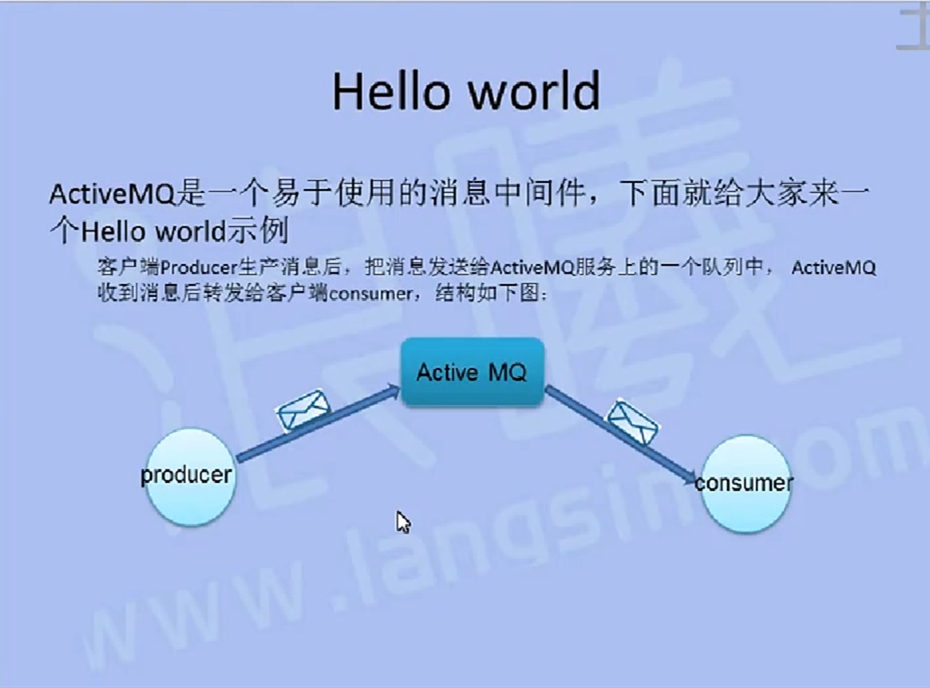ActiveMQ消息中间件Producer和Consumer
生产者代码:
|
1
2
3
4
5
6
7
8
9
10
11
12
13
14
15
16
17
18
19
20
21
22
23
24
25
26
27
28
29
30
31
32
33
34
35
36
37
38
39
40
41
42
43
44
45
46
47
48
49
50
51
52
53
54
55
56
57
58
59
60
61
62
63
64
65
66
67
68
69
70
71
72
73
|
package com.java1234.activemq;import javax.jms.Connection;import javax.jms.ConnectionFactory;import javax.jms.Destination;import javax.jms.JMSException;import javax.jms.MessageProducer;import javax.jms.Session;import javax.jms.TextMessage;import org.apache.activemq.ActiveMQConnection;import org.apache.activemq.ActiveMQConnectionFactory;/** * 消息生产者 * @author Administrator * */public class JMSProducer { private static final String USERNAME=ActiveMQConnection.DEFAULT_USER; // 默认的连接用户名 private static final String PASSWORD=ActiveMQConnection.DEFAULT_PASSWORD; // 默认的连接密码 private static final String BROKEURL=ActiveMQConnection.DEFAULT_BROKER_URL; // 默认的连接地址 private static final int SENDNUM=10; // 发送的消息数量 public static void main(String[] args) { ConnectionFactory connectionFactory; // 连接工厂 Connection connection = null; // 连接 Session session; // 会话 接受或者发送消息的线程 Destination destination; // 消息的目的地 MessageProducer messageProducer; // 消息生产者 // 实例化连接工厂 connectionFactory=new ActiveMQConnectionFactory(JMSProducer.USERNAME, JMSProducer.PASSWORD, JMSProducer.BROKEURL); try { connection=connectionFactory.createConnection(); // 通过连接工厂获取连接 connection.start(); // 启动连接 session=connection.createSession(Boolean.TRUE, Session.AUTO_ACKNOWLEDGE); // 创建Session destination=session.createQueue("FirstQueue1"); // 创建消息队列 messageProducer=session.createProducer(destination); // 创建消息生产者 sendMessage(session, messageProducer); // 发送消息 session.commit(); } catch (Exception e) { // TODO Auto-generated catch block e.printStackTrace(); } finally{ if(connection!=null){ try { connection.close(); } catch (JMSException e) { // TODO Auto-generated catch block e.printStackTrace(); } } } } /** * 发送消息 * @param session * @param messageProducer * @throws Exception */ public static void sendMessage(Session session,MessageProducer messageProducer)throws Exception{ for(int i=0;i<JMSProducer.SENDNUM;i++){ TextMessage message=session.createTextMessage("ActiveMQ 发送的消息"+i); System.out.println("发送消息:"+"ActiveMQ 发送的消息"+i); messageProducer.send(message); } }} |
消费者分两种:
1.主动接受消息receive()
|
1
2
3
4
5
6
7
8
9
10
11
12
13
14
15
16
17
18
19
20
21
22
23
24
25
26
27
28
29
30
31
32
33
34
35
36
37
38
39
40
41
42
43
44
45
46
47
48
49
50
51
52
53
54
|
package com.java1234.activemq;import javax.jms.Connection;import javax.jms.ConnectionFactory;import javax.jms.Destination;import javax.jms.JMSException;import javax.jms.MessageConsumer;import javax.jms.Session;import javax.jms.TextMessage;import org.apache.activemq.ActiveMQConnection;import org.apache.activemq.ActiveMQConnectionFactory;/** * 消息消费者 * @author Administrator * */public class JMSConsumer { private static final String USERNAME=ActiveMQConnection.DEFAULT_USER; // 默认的连接用户名 private static final String PASSWORD=ActiveMQConnection.DEFAULT_PASSWORD; // 默认的连接密码 private static final String BROKEURL=ActiveMQConnection.DEFAULT_BROKER_URL; // 默认的连接地址 public static void main(String[] args) { ConnectionFactory connectionFactory; // 连接工厂 Connection connection = null; // 连接 Session session; // 会话 接受或者发送消息的线程 Destination destination; // 消息的目的地 MessageConsumer messageConsumer; // 消息的消费者 // 实例化连接工厂 connectionFactory=new ActiveMQConnectionFactory(JMSConsumer.USERNAME, JMSConsumer.PASSWORD, JMSConsumer.BROKEURL); try { connection=connectionFactory.createConnection(); // 通过连接工厂获取连接 connection.start(); // 启动连接 session=connection.createSession(Boolean.FALSE, Session.AUTO_ACKNOWLEDGE); // 创建Session destination=session.createQueue("FirstQueue1"); // 创建连接的消息队列 messageConsumer=session.createConsumer(destination); // 创建消息消费者 while(true){ TextMessage textMessage=(TextMessage)messageConsumer.receive(100000); if(textMessage!=null){ System.out.println("收到的消息:"+textMessage.getText()); }else{ break; } } } catch (JMSException e) { // TODO Auto-generated catch block e.printStackTrace(); } }} |
2.使用listener被动监听消息(非阻塞的)(观察者模式)
Listener代码
|
1
2
3
4
5
6
7
8
9
10
11
12
13
14
15
16
17
18
19
20
21
22
23
24
25
26
|
package com.java1234.activemq;import javax.jms.JMSException;import javax.jms.Message;import javax.jms.MessageListener;import javax.jms.TextMessage;/** * 消息监听 * @author Administrator * */public class Listener implements MessageListener{ @Override public void onMessage(Message message) { // TODO Auto-generated method stub try { System.out.println("收到的消息:"+((TextMessage)message).getText()); } catch (JMSException e) { // TODO Auto-generated catch block e.printStackTrace(); } }} |
|
1
2
3
4
5
6
7
8
9
10
11
12
13
14
15
16
17
18
19
20
21
22
23
24
25
26
27
28
29
30
31
32
33
34
35
36
37
38
39
40
41
42
43
44
45
46
47
|
package com.java1234.activemq;import javax.jms.Connection;import javax.jms.ConnectionFactory;import javax.jms.Destination;import javax.jms.JMSException;import javax.jms.MessageConsumer;import javax.jms.Session;import javax.jms.TextMessage;import org.apache.activemq.ActiveMQConnection;import org.apache.activemq.ActiveMQConnectionFactory;/** * 消息消费者 * @author Administrator * */public class JMSConsumer2 { private static final String USERNAME=ActiveMQConnection.DEFAULT_USER; // 默认的连接用户名 private static final String PASSWORD=ActiveMQConnection.DEFAULT_PASSWORD; // 默认的连接密码 private static final String BROKEURL=ActiveMQConnection.DEFAULT_BROKER_URL; // 默认的连接地址 public static void main(String[] args) { ConnectionFactory connectionFactory; // 连接工厂 Connection connection = null; // 连接 Session session; // 会话 接受或者发送消息的线程 Destination destination; // 消息的目的地 MessageConsumer messageConsumer; // 消息的消费者 // 实例化连接工厂 connectionFactory=new ActiveMQConnectionFactory(JMSConsumer2.USERNAME, JMSConsumer2.PASSWORD, JMSConsumer2.BROKEURL); try { connection=connectionFactory.createConnection(); // 通过连接工厂获取连接 connection.start(); // 启动连接 session=connection.createSession(Boolean.FALSE, Session.AUTO_ACKNOWLEDGE); // 创建Session destination=session.createQueue("FirstQueue1"); // 创建连接的消息队列 messageConsumer=session.createConsumer(destination); // 创建消息消费者 messageConsumer.setMessageListener(new Listener()); // 注册消息监听 } catch (JMSException e) { // TODO Auto-generated catch block e.printStackTrace(); } }} |
如果想主动的去接受消息,而不用异步消息监听的话,把consumer.setMessageListener(this)改为Message message = consumer.receive(),手动去调用MessageConsumer的receive方法即可。
参考文章:
